Finding Unica in the RISM Database
The ability to trace the distribution of musical sources is one of the strengths of the RISM database. Music manuscripts are by their very nature unique, while any given printed edition potentially exists in multiple copies. Finding those printed editions that have only survived in a single known copy has benefits for all kinds of RISM users. Performers can find rare materials to bring to life on the stage, music antiquarians can assess the scarcity of what they offer, musicologists can focus on rare publications, librarians can target unica in digitization projects, and RISM contributors can prioritize their institution’s unique copies when cataloging their collections for RISM.
Fortunately, the question of which early printed music editions are unica can be answered with a few clicks, at least with respect to the editions that were included in RISM Series A/I and B/I, which have already been integrated in our online database. It is also possible to locate unica within a specific country or region.
When searching for unica, a familiarity with RISM’s library sigla will be necessary. For more information, see our About RISM Library Sigla page.
Finding unica
Go to RISM Online and scroll to the bottom of the Sources page. In the box under Holding institutions, enter the siglum of the collection you are interested in and click on it from the drop-down menu that appears.
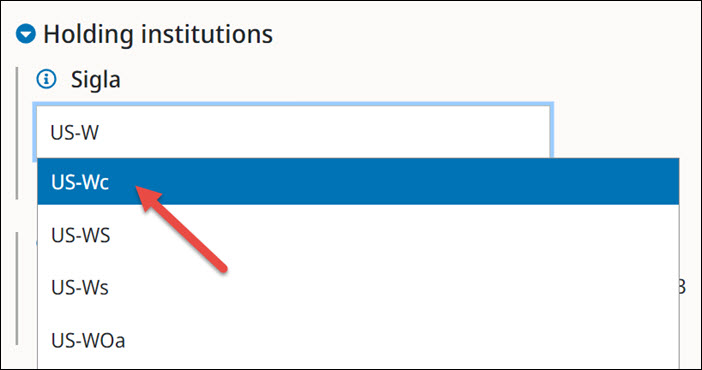
Then under Number of holdings, check the box next to 1.
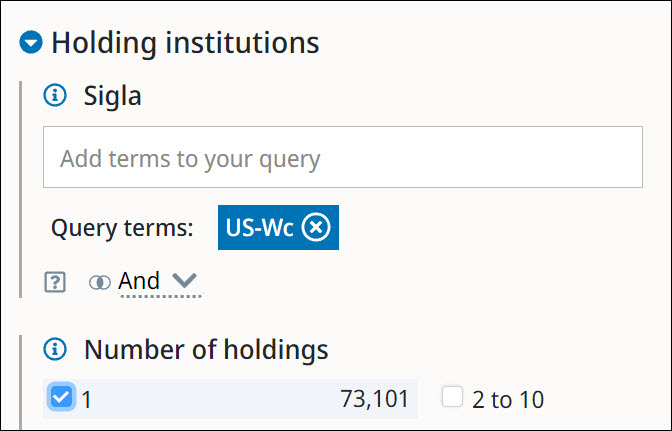
Note that the preview number of “73,101” has not yet been updated to reflect your search.
Scroll back up to the top of the page and you’ll see some options under Result types. If you toggle Hide source contents then your results will not include any analytic records for individual pieces within an edition.
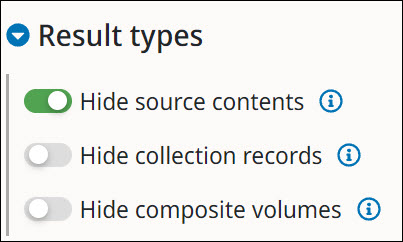
Now you can click Show search results at the top of the screen. You will then get a list of the institution’s printed editions that exist in only one copy (as far as the RISM database is aware).
As examples, here are searches for unica in the following libraries:
- Biblioteca Nacional de Portugal (P-Ln)
- British Library (GB-Lbl)
- Library of Congress (US-Wc)
- Musik- och teaterbiblioteket (S-Skma)
Keep in mind the following concerning the word “unica.” For most libraries the list in RISM Online will indeed exclusively consist of editions that exist in only one copy. These holdings correspond to the items that were described in RISM Series A/I (editions containing works by a single composer before 1800) and RISM Series B/I (printed anthologies of the 16th and 17th centuries). When these well-known blue RISM volumes were in the making, all surviving copies were reported and this information served as a basis when it was later transferred to the online database. At the same time, for libraries that include their printed editions from later time periods – for example from the 19th century, which was not covered by the A/I and B series – the lack of another holding library in the RISM database does not necessarily imply that further copies could not be owned by other institutions worldwide. It likely just means that other holding libraries have not reported their copies to RISM yet.
Finding unica by composer
The techniques above can be used in RISM Online to find unique copies by composer. Instead of using the Holding institutions search, select the person under Composer/Author. You might have to enter the composer’s name in the Words anywhere search box before the name appears in the filters.
As examples, here are searches for composers that have editions that are unica:
Finding items unique to a region
In RISM Online, you can search for all unica in a specific country. For this, use a query in the Words anywhere search at the top of the page rather than using the Holding institutions search.
- In the Words anywhere box, enter the field name siglum: directly followed by (no space) a truncated siglum. The truncated siglum will be the letter(s) for the country’s abbreviation, a hyphen, and an asterisk. Examples:
- siglum:F-* for all sources in France
- siglum:US-* for all sources in the United States
- As described above, under Number of holdings, check the box next to 1.
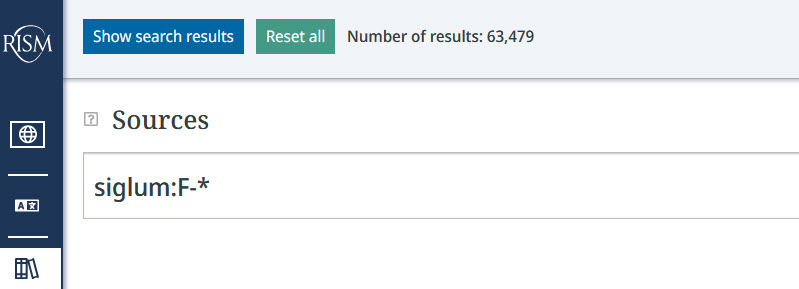
As examples, here are searches for unica by country:
The RISM Catalog clusters library sigla in the facets. These are found on the main page of search results, on the left under Library siglum.
If you search for printed editions by library siglum and you see multiple sigla in the facets, that means that other institutions own copies of the same editions. Here is what the Library siglum facet can look like after searching for printed Händel editions in the British Library (GB-Lbl):
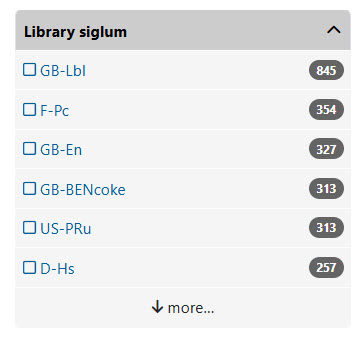
If a print has only one institution listed, then it is a unique copy:

For prints with multiple sigla listed, you can examine the list to see what editions are unique to your country or region. For example, the RISM Catalog lists around 40 printed editions by William Croft. By expanding the Library siglum filter (click more… then see all…), we see where unique copies are by nation: Italy, Ireland, the Netherlands, and Russia, among other countries.
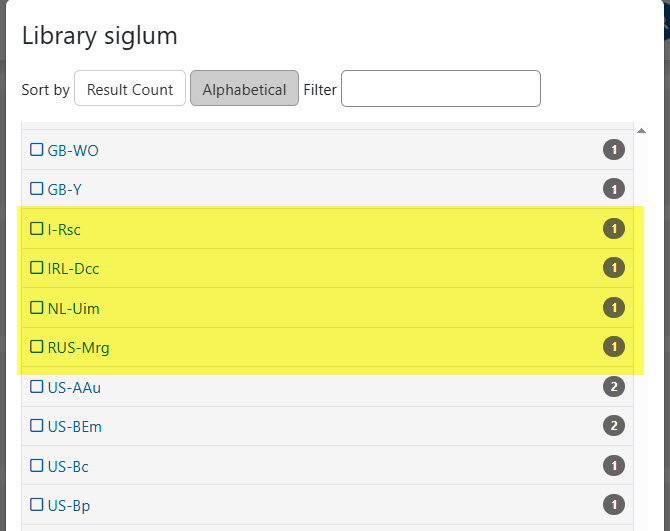
A Spanish library can see what Lully editions are found in Spain. A British institution can check whether there are other British libraries with a certain edition by Purcell, or if most of the other holding libraries are outside of the UK. Finding material that is rare or unique to your country can help librarians who are planning digitization projects or if they are considering purchases from antiquarian dealers.
